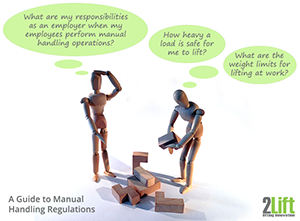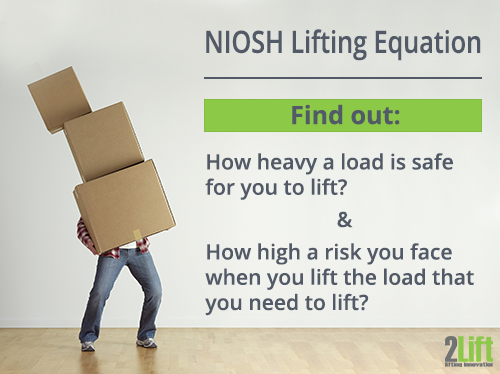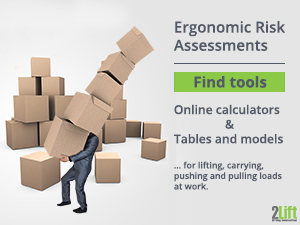Ergonomics Assessment Tools and Employer Guidelines for Manual Handling Operations in Spain
If you're an employer in Spain looking for ergonomics assessment tools for the manual handling of loads and guidelines for lifting and carrying, you will find that there is quite a lot of material available - both for occupational safety and health professionals and the regular employer who needs to make sure his workplace and work activities are safe for his workers.
On this page, you'll find:
- A quick introduction to the main authority who deals with communicating about manual handling in Spain
- Information about responsibilities of the employer when it comes to protecting their workers from risks from manual handling
- Links to ergonomic guidelines on how to lift an object
- Information on and links to ergonomic risk assessments for the manual handling of loads in Spain
- Weight limits for lifting in Spain
- Force limits for pushing and pulling in Spain
The Authority Responsible for Manual Handling in Spain
In Spain the National Institute of Safety, Health and Welfare at Work (INSSBT, Instituto Nacional de Seguridad, Salud y Bienestar en el Trabajo) is the technical and scientific body responsible for communicating EU Directives on manual handling to a national level. This also makes the National Institute of Safety, Health and Welfare at Work Spain's national OSHA focal point.
The goals of the National Institute of Safety, Health and Welfare at Work is to reduce the number of accidents at work as well as occupational diseases. This aim is to be reached through a preventive informational strategy.
More specifically in their Strategy on Occupational Safety and Health (English abstract) Estrategia Seguridad y Salud en el Trabajo 2015 - 2020 it is said that Spain will have a primary focus on occupational risk prevention (which by the way is well in line with other EU countries). Here, sectors in which musculoskeletal disorders (as well as a few other areas) are prevalent are mentioned as focus areas which needs special attention and improvement.
The overall law regulating the field of occupational risk prevention is Law 31/95.
In the Royal Decree 487/1997 on the minimum safety and health provisions relating to the manual handling of loads, the EU Directive 90/269 / EEC (also known as the Manual Handling Directive) has been transposed into Spanish law.
The Manual Handling Responsibilities of the Employer
In this Royal Decree, you'll be able to find the legislative responsibilities of the employer in the risk prevention of manual handling.
In short, it is said that:
The employer must take technical or organizational measures, primarily via mechanical aids, in to avoid the manual handling of loads by workers.
If manual handling cannot be avoided, the employer must take organizational measures or provide the means by which the worker can reduce the risk of manual handling. The employer must also evaluate the risks pertaining to manual handling.
Also, employers must properly monitor the workers' health when their activities involve manual handling.
5 Risk Factors of Manual Handling
Furthermore, the employer must assess the scope of the following five (mainly MSD related) risk factors of manual handling:
- The characteristics of the load (is it too heavy, too large, difficult to hold, held or placed too far away from the body centre etc.)
- The necessary physical effort (requires a twisting of the trunk or other unfavourable body posture etc.)
- The characteristics of the work environment (insufficient space for handling, uneven or sloping flooring, too high or low temperature, poor lighting etc.)
- The requirements of the activity (too long an activity, insufficient rest, not self-determined pace etc.)
- The individual risk factors (too unfit for task, not adequately trained, already suffering from MSD related problems etc.)
Manual Handling Guidelines and Ergonomics Assessments of Lifting Risks in Spain
Ergonomic Guidelines on How to Lift an Object
The National Institute for Safety and Hygiene at Work (El Instituto Nacional de Seguridad e Higiene en el Trabajo (INSHT)) has also published a very quick-to-read guide (consists mostly of images) for how to lift in the most ergonomically correct fashion: Manipulación manual de cargas. Pasos a seguir para levantar una carga (The Manual Handling of Loads. Steps to follow to lift a load (own translation, no English version available))
In short the ergonomic guidelines for lifting an object are (you need to see the images on the guide to get the full benefit of the steps):
- Plan the lifting procedure well.
- Place your feet correctly.
- Adopt the optimal lifting position when starting the lift.
- Get a firm and good grip on the load.
- Avoid twisting the trunk.
- Keep the load close to the centre of your body.
- Deposit the load in the most optimal fashion.
However, being aware of the ergonomic guidelines isn't enough, as an employer you also need to perform risk assessments of the manual handling tasks.
Ergonomic Risk Assessments for the Manual Handling of Loads in Spain
The National Institute for Safety and Hygiene at Work has developed procedures and methods designed to reduce the risk of occupational hazards, including ergonomic ones.
In their document Manual para la evaluación y prevención de riesgos ergonómicos y psicosociales en la PYME (Manual for the assessment and prevention of ergonomic and psychosocial risks in SMEs) (exists only in Spanish, The title is our own translation into English, SMEs = Small and medium-sized enterprises)) they provide ergonomics assessment tools for high risk occupational activities, such as the manual handling of loads.
In this document they recognize that the problem of risk prevention procedures in small to medium-sized companies is due to the lack of resources, and thus target their hazard identification and risk assessment tools for Spanish employers who are (for the most part by far) non-experts in the ergonomics of manual handling and lifting heavy objects. Thus the risk assessment tools are simple in nature and quick and easy to use.
This does also mean, however, that the risk assessments will be less accurate than those performed by safety and health personnel, and in case of any doubt, the employer should consult a specialist for a more accurate result.
In the Manual para la evaluación y prevención de riesgos ergonómicos y psicosociales en la PYME one of the first things that is advised in the ergonomic risk assessment of the manual handling of loads is to identify the risks.
For that end, there is a table with risk factors on page 10, where you need to tick off the presence of certain risk factors such as:
- If the load is heavier than 6 kg
- If the load weighs 3 kg or less but has to be handled or lifted in a posture that puts stress on the body e.g. handling the load far away from the hips and over shoulders, knees, twisting the trunk etc.
- If the load is handled more than one time per minute
- If the worker is sitting down while handling the load
Those manual handling risk factors above only deal with handling the load specifically. There are many more factors to consider in the table.
Risk Assessment for Lifting in Spain
In Manual para la evaluación y prevención de riesgos ergonómicos y psicosociales en la PYME there is a risk assessment for three types of manual handling:
- Lifting the load while standing.
- Lifting the load while sitting.
- Carrying the load.
What you will find out when doing this risk assessment is whether the load handled is within the recommended weigh limit. In other words, you will find out, if your load is too heavy.
The risk assessment provides a result based on five variables:
- The load's position in relation to the body.
- The vertical 'travel' distance of the load from the start of the lift to the end.
- How much you need to twist the trunk.
- How good a grip the load has.
- The frequency and duration of the manual handling task.
Every time a condition isn't optimal, you need to multiply with a certain value, which will bring the recommended weight of the load down.
You will find an example of how to fill out the ergonomics assessment sheet starting on page 32. This is an example of an ergonomic risk assessment where the actual load is heavier than the recommended weight.
The risk assessment for manual handling all ready to print out or download you will find here: Método para la evaluación del riesgo por la manipulación manual de cargas (Method for risk assessment of the manual handling of loads (only available in Spanish)).
Weight Limits for Lifting in Spain
 If you are a man you may under optimal conditions (optimal posture, load placement, work area conditions etc.) lift up to a maximum of:
If you are a man you may under optimal conditions (optimal posture, load placement, work area conditions etc.) lift up to a maximum of:
If you are a woman, a senior or youth worker you must multiply the recommended weight limit with 0.6 (reference: Manual para la evaluación y prevención de riesgos ergonómicos y psicosociales en la PYME, page 23).
Thus for women, a seniors or youth workers the maximum weigh limit for lifting under optimal conditions is:
Whenever conditions worsen, the weight of the load must be reduced.
Furthermore, if the distance of the transport of loads equals or is less than 10 meters, you allowed to handle up a total of 10 ton per day.
If the distance is more than 10 meters, the recommended total weigh limit per day falls to 6 ton.
Other Risk Assessment Tools for Lifting

The NIOSH Lifting Equation
Another tool which is recommended is the NIOSH Lifting Equation. This tool may provide a more precise risk assessment of a lifting task, but it is somewhat more complicated to use and is mostly used by professionals in the field of occupational safety and health.
Force Limits for Pushing and Pulling in Spain
 INSHT also provides limit values for pushing and pulling a load.
INSHT also provides limit values for pushing and pulling a load.
The maximum force that must not be exceeded is:
- 25 kg (250 N) when starting or stopping the transport of a load.
- 10 kg (100 N) to maintain the moving of the load.
Risk Assessment for Pushing and Pulling in Spain
If you want to perform a risk assessment on pushing and pulling you can use this one, based on the data provided by Snook and Ciriello.
When using this calculator you get a maximum mass weigh recommended for your operation which a certain percentage of the population can perform without risk.
Online Resources on Manual Handling in Spain

Information Disclaimer
We have done our very best to ensure the accuracy and reliability of the information presented on this page. However, we cannot guarantee the correctness of any information (regulations change from time to time, responsibilities change hands, etc.). Thus we cannot accept any responsibility or liability for the accuracy, content, completeness, legality, or reliability of the information provided here.
If, however, you are aware of any outdated or incorrect information on this page, you are very welcome to contact us, so we can bring our page up to date.
Other Pages on Manual Handling Regulations

Manual Handling Regulations Guide |

The NIOSH Lifting Equation |

Ergonomic Risk Assessment Tools |
Country Specific Pages with Ergonomic Guidelines and Risk Assessment Tools

UK |

Germany |

Austria |

France |

Ireland |

The Netherlands |

Denmark |

Sweden |

Spain |

Portugal |

Italy |

Switzerland |

Norway |

Canada |

Australia |
|
|
|